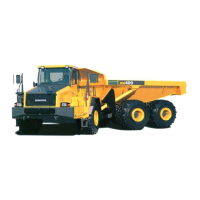.
OPERATION
OPERATION
HANDLING TIRES
PRECAUTIONS WHEN HANDLING TIRES
WARNING
To ensure safety, the defective tires given below must be replaced with
new tires.
Tires where the bead wire has been cut, broken, or greatly deformed
Excessively worn tires where more than 1/4 of the circumference of the
carcass ply (excluding the breaker) is exposed
Tires where damage to the carcass exceeds 1/3 of the tire width
Tires where ply separation has occurred
Tires where radial cracks extend to the carcass
Tires where there is abnormal deterioration, deformation, and damage,
and the tire cannot withstand use.
Please contact your Komatsu distributor when replacing the tires.
It is dangerous to jack up the machine without taking due care.
PRECAUTIONS FOR LONG DISTANCE TRAVEL
If the machine travels continuously at high speed for a long distance, there will be a marked increase in the
generation of heat in the tire. This may cause premature damage to the tire, so be careful of the following points.
Travel only when empty.
Check the tire inflation pressure before starting for the day when the tires are cold, and adjust to the following
inflation pressure.
Do not reduce the tire inflation pressure when traveling.
Tire size
Inflation pressure
[MPa (kgf/cm
2
, PSI)]
29.5-R25 VLT (standard)
0.37 (3.8, 54.0)
29.5-R25 VKT (standard)
29.5-R25 XADT (standard) 0.39 (4.0, 56.8)
29.5-R25 RL2+ (standard) 0.40 (4.1, 58.2)
875/65 R29 (if equipped) 0.44 (4.5, 63.9)
NOTICE
If tire is used under the condition of lower than the above values, it is possible that the rim would be damaged. Inflation pressure
of the tire should be maintained and controlled with the range of +0 to +0.03 MPa (0.3 kgf/cm
2
, 4.3 PSI) of the above correspoinding
values.
The maximum travel speed must be kept to less than 40 km/h (24.9 MPH). Stop for at least one hour for every
one hour of travel to allow the tires and other components to cool down.
Never travel with water or dry ballast in the tires.
3 - 109

